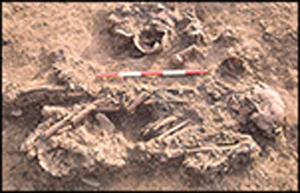Crossref Citations
This article has been cited by the following publications. This list is generated based on data provided by
Crossref.
Belford, Paul
2019.
Ensuring Archaeology in the Planning System Delivers Public Benefit.
Public Archaeology,
Vol. 18,
Issue. 4,
p.
191.
Brück, Joanna
2021.
Ancient DNA, kinship and relational identities in Bronze Age Britain.
Antiquity,
Vol. 95,
Issue. 379,
p.
228.
Sabaux, Charlotte
Veselka, Barbara
Capuzzo, Giacomo
Snoeck, Christophe
Sengeløv, Amanda
Hlad, Marta
Warmenbol, Eugène
Stamataki, Elisavet
Boudin, Mathieu
Annaert, Rica
Dalle, Sarah
Salesse, Kevin
Debaille, Vinciane
Tys, Dries
Vercauteren, Martine
and
De Mulder, Guy
2021.
Multi-proxy analyses reveal regional cremation practices and social status at the Late Bronze Age site of Herstal, Belgium.
Journal of Archaeological Science,
Vol. 132,
Issue. ,
p.
105437.
Booth, Thomas J.
Brück, Joanna
Brace, Selina
and
Barnes, Ian
2021.
Tales from the Supplementary Information: Ancestry Change in Chalcolithic–Early Bronze Age Britain Was Gradual with Varied Kinship Organization.
Cambridge Archaeological Journal,
Vol. 31,
Issue. 3,
p.
379.
BLOXAM, ANNA
and
PARKER PEARSON, MIKE
2022.
Funerary Diversity and Cultural Continuity: The British Beaker Phenomenon Beyond the Stereotype.
Proceedings of the Prehistoric Society,
Vol. 88,
Issue. ,
p.
261.
Brück, Joanna
and
Booth, Thomas J.
2022.
The Power of Relics: The Curation of Human Bone in British Bronze Age Burials.
European Journal of Archaeology,
Vol. 25,
Issue. 4,
p.
440.
Moore, Hazel
Wilson, Graeme
Ni Challanain, Mairead
McCormick, Maeve
Marshall, Peter D.
Dulias, Katharina
Foody, M. George B.
Justeau, Pierre
Pala, Maria
Richards, Martin B.
and
Edwards, Ceiridwen J.
2022.
Migration and community in Bronze Age Orkney: innovation and continuity at the Links of Noltland.
Antiquity,
Vol. 96,
Issue. 387,
p.
541.
Moreno-Ibáñez, Miguel Ángel
Saladié, Palmira
Morales, Juan I.
Cebrià, Artur
and
Fullola, Josep Maria
2022.
Inhumation and cremation: identifying funerary practices and reuse of space through forensic taphonomy at Cova Foradada (Calafell, Spain).
Archaeological and Anthropological Sciences,
Vol. 14,
Issue. 4,
BRÜCK, JOANNA
and
BOOTH, THOMAS J.
2022.
The Ambivalent Dead: Curation, Excarnation and Complex Post-mortem Trajectories in Middle and Late Bronze Age Britain.
Proceedings of the Prehistoric Society,
Vol. 88,
Issue. ,
p.
193.
Knight, Matthew G.
2023.
Nostalgia in the prehistoric archaeological record.
Current Opinion in Psychology,
Vol. 50,
Issue. ,
p.
101560.
Pearson, Mike Parker
2023.
Living with the dead: mummification and post-mortem treatment in Bronze Age Britain.
Archaeology International,
Vol. 26,
Issue. 1,
Guareschi, Edda Emanuela
Magni, Paola Annarosa
and
Berry, Heather G.
2023.
Potential Issues in the Conservation of Bone and Teeth in Maritime Archaeology.
Heritage,
Vol. 6,
Issue. 2,
p.
779.
Thompson, Jess E.
Panella, Sofia
Booth, Thomas J.
Soncin, Silvia
Rajkovaca, Tonko
Belcastro, Maria Giovanna
Isetti, Eugenia
Mariotti, Valentina
Muntoni, Italo Maria
Radina, Francesca
Sivilli, Sandra
Traverso, Antonella
Tafuri, Mary Anne
Robb, John E.
and
Halcrow, Siân E.
2024.
Histotaphonomic analysis of bone bioerosion reveals a regional framework of diverse deathways in the Neolithic of Southeast Italy.
PLOS ONE,
Vol. 19,
Issue. 6,
p.
e0304058.
Nance, David Alexander
2024.
Holme I (Seahenge) and Holme II: ritual responses to climate change in Early Bronze Age Britain.
GeoJournal,
Vol. 89,
Issue. 2,
Rowland, Jake T.
and
Thompson, Jess E.
2024.
Bridlington Boulevard Revisited: New Insights into Pit and Post-hole Cremations in Neolithic Britain.
Cambridge Archaeological Journal,
Vol. 34,
Issue. 3,
p.
453.
Heit, Ilia
2024.
How Long Does a Memory Last? Bayesian Chronological Modelling and the Temporal Scope of Commemorative Practices at Aeneolithic Monjukli Depe, Turkmenistan.
Cambridge Archaeological Journal,
Vol. 34,
Issue. 4,
p.
757.
Hanson, Ian
2024.
Encyclopedia of Archaeology (Second Edition).
p.
102.
Crema, E.R.
Bloxam, A.
Stevens, C.J.
and
Vander Linden, M.
2024.
Modelling diffusion of innovation curves using radiocarbon data.
Journal of Archaeological Science,
Vol. 165,
Issue. ,
p.
105962.
Sabaux, Charlotte
Snoeck, Christophe
Capuzzo, Giacomo
Veselka, Barbara
Dalle, Sarah
Warmenbol, Eugène
Stamataki, Elisavet
Hlad, Marta
Sengeløv, Amanda
Debaille, Vinciane
Boudin, Mathieu
Salesse, Kevin
Annaert, Rica
Vercauteren, Martine
and
De Mulder, Guy
2024.
Novel multidisciplinary approach detects multiple individuals within the same Late Bronze–Early Iron Age cremation graves.
Radiocarbon,
Vol. 66,
Issue. 4,
p.
761.
Bricking, A.
Revell, B.
and
Madgwick, R.
2025.
Death and Dichotomy: Exploring Varied Human and Animal Depositional Practices in the Iron Age at Battlesbury Bowl, UK, through Histotaphonomy.
Journal of Archaeological Method and Theory,
Vol. 32,
Issue. 1,



